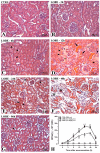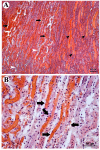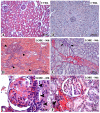Mechanisms of acute kidney injury induced by experimental Lonomia obliqua envenomation
- PMID: 24798088
- PMCID: PMC4401067
- DOI: 10.1007/s00204-014-1264-0
Mechanisms of acute kidney injury induced by experimental Lonomia obliqua envenomation
Abstract
Lonomia obliqua caterpillar envenomation causes acute kidney injury (AKI), which can be responsible for its deadly actions. This study evaluates the possible mechanisms involved in the pathogenesis of renal dysfunction. To characterize L. obliqua venom effects, we subcutaneously injected rats and examined renal functional, morphological and biochemical parameters at several time points. We also performed discovery-based proteomic analysis to measure protein expression to identify molecular pathways of renal disease. L. obliqua envenomation causes acute tubular necrosis, which is associated with renal inflammation; formation of hematic casts, resulting from intravascular hemolysis; increase in vascular permeability and fibrosis. The dilation of Bowman's space and glomerular tuft is related to fluid leakage and intra-glomerular fibrin deposition, respectively, since tissue factor procoagulant activity increases in the kidney. Systemic hypotension also contributes to these alterations and to the sudden loss of basic renal functions, including filtration and excretion capacities, urinary concentration and maintenance of fluid homeostasis. In addition, envenomed kidneys increase the expression of proteins involved in cell stress, inflammation, tissue injury, heme-induced oxidative stress, coagulation and complement system activation. Finally, the localization of the venom in renal tissue agrees with morphological and functional alterations, suggesting also a direct nephrotoxic activity. In conclusion, the mechanisms of L. obliqua-induced AKI are complex involving mainly glomerular and tubular functional impairment and vascular alterations. These results are important to understand the mechanisms of renal injury and may suggest more efficient ways to prevent or attenuate the pathology of Lonomia's envenomation.
Figures










Similar articles
-
Acute Lonomia obliqua caterpillar envenomation-induced physiopathological alterations in rats: evidence of new toxic venom activities and the efficacy of serum therapy to counteract systemic tissue damage.Toxicon. 2013 Nov;74:179-92. doi: 10.1016/j.toxicon.2013.08.061. Epub 2013 Aug 29. Toxicon. 2013. PMID: 23994591
-
Renal and vascular effects of kallikrein inhibition in a model of Lonomia obliqua venom-induced acute kidney injury.PLoS Negl Trop Dis. 2019 Feb 14;13(2):e0007197. doi: 10.1371/journal.pntd.0007197. eCollection 2019 Feb. PLoS Negl Trop Dis. 2019. PMID: 30763408 Free PMC article.
-
Urine proteomic analysis reveals alterations in heme/hemoglobin and aminopeptidase metabolism during Lonomia obliqua venom-induced acute kidney injury.Toxicol Lett. 2021 May 1;341:11-22. doi: 10.1016/j.toxlet.2021.01.012. Epub 2021 Jan 17. Toxicol Lett. 2021. PMID: 33472085
-
Lonomia obliqua venom: In vivo effects and molecular aspects associated with the hemorrhagic syndrome.Toxicon. 2010 Dec 15;56(7):1103-12. doi: 10.1016/j.toxicon.2010.01.013. Epub 2010 Jan 28. Toxicon. 2010. PMID: 20114060 Review.
-
The venom of the Lonomia caterpillar: an overview.Toxicon. 2007 May;49(6):741-57. doi: 10.1016/j.toxicon.2006.11.033. Epub 2007 Jan 10. Toxicon. 2007. PMID: 17320134 Review.
Cited by
-
Zika Virus Infection of Human Mesenchymal Stem Cells Promotes Differential Expression of Proteins Linked to Several Neurological Diseases.Mol Neurobiol. 2019 Jul;56(7):4708-4717. doi: 10.1007/s12035-018-1417-x. Epub 2018 Oct 30. Mol Neurobiol. 2019. PMID: 30377986 Free PMC article.
-
Lonomia obliqua Envenoming and Innovative Research.Toxins (Basel). 2021 Nov 23;13(12):832. doi: 10.3390/toxins13120832. Toxins (Basel). 2021. PMID: 34941670 Free PMC article. Review.
-
Lonomi a obliq ua (Caterpillar)-Related Kidney Failure: A Rare Histopathology Register.Kidney Med. 2024 Jun 14;6(8):100852. doi: 10.1016/j.xkme.2024.100852. eCollection 2024 Aug. Kidney Med. 2024. PMID: 39105069 Free PMC article. No abstract available.
-
Molecular Characterization of Three Novel Phospholipase A₂ Proteins from the Venom of Atheris chlorechis, Atheris nitschei and Atheris squamigera.Toxins (Basel). 2016 Jun 1;8(6):168. doi: 10.3390/toxins8060168. Toxins (Basel). 2016. PMID: 27258312 Free PMC article.
-
Protective Effects of Carbon Dots Derived from Phellodendri Chinensis Cortex Carbonisata against Deinagkistrodon acutus Venom-Induced Acute Kidney Injury.Nanoscale Res Lett. 2019 Dec 16;14(1):377. doi: 10.1186/s11671-019-3198-1. Nanoscale Res Lett. 2019. PMID: 31845094 Free PMC article.
References
-
- Abbate M, Zoja C, Remuzzi G. How does proteinuria cause progressive renal damage? J Am Soc Nephrol. 2006;17:2974–2984. - PubMed
-
- Alvarez-Flores MP, Fritzen M, Reis CV, Chudzinski-Tavassi AM. Losac, a factor X activator from Lonomia obliqua bristle extract: its role in the pathophysiological mechanisms and cell survival. Biochem Biophys Res Commun. 2006;343:1216–1223. - PubMed
-
- Basnakian AG, Kaushal GP, Shah SV. Apoptotic pathways of oxidative damage to renal tubular epithelial cells. Antioxid Redox Signal. 2002;4(6):915–924. - PubMed
-
- Berger M, Reck J, Jr., Terra RM, Pinto AF, Termignoni C, Guimarães JA. Lonomia obliqua caterpillar envenomation causes platelet hypoaggregation and blood incoagulability in rats. Toxicon. 2010;55(1):33–44. - PubMed
Publication types
MeSH terms
Substances
Grants and funding
LinkOut - more resources
Full Text Sources
Other Literature Sources
Medical

